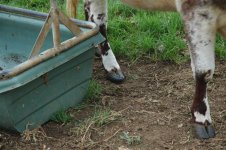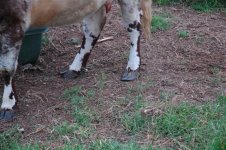Duncraggan
Well-known member
- Joined
- Jun 2, 2012
- Messages
- 821
Two young Shorthorn cows of mine have overgrown back hooves. Ages 40 months and 33 months. Only third case ever for me in ten years of pedigree cattle breeding, the first was a cow of approximately 8 years at the beginning of the year. None are related in any way to each other, in fact, the 8-year old was a bought in cow.
None have had any sign of weak pasterns although they seem to have shallow heels, possibly due to the overgrown hooves? The older cow seemed to lose condition, weaned a substandard calf and was sold, together with her heifer calf at weaning.
Both these current two younger cows are not in too bad condition, albeit that they are receiving some supplementary protein and energy as they are first calvers. The one has a very good heifer AI calf, the other a below-average AI bull calf. I still have both their dams, 6 and 7 years old, without the same problem.
I am a grass based producer, only a phosphate lick is given in normal years. I started to give my first calf cows and the late calving cows a supplement this year to get them bred back faster and so that I can shorten my breeding season to 65 days from 75 last year and over 90 days the previous year. I don't believe the supplementation is the cause.
Should I sell the cows and their progeny, or keep the very good calf and only sell the rest to the abattoir? Could this problem maybe correct itself? Trimming hooves is not an option!
Some opinions would be very welcome! Thanks.
None have had any sign of weak pasterns although they seem to have shallow heels, possibly due to the overgrown hooves? The older cow seemed to lose condition, weaned a substandard calf and was sold, together with her heifer calf at weaning.
Both these current two younger cows are not in too bad condition, albeit that they are receiving some supplementary protein and energy as they are first calvers. The one has a very good heifer AI calf, the other a below-average AI bull calf. I still have both their dams, 6 and 7 years old, without the same problem.
I am a grass based producer, only a phosphate lick is given in normal years. I started to give my first calf cows and the late calving cows a supplement this year to get them bred back faster and so that I can shorten my breeding season to 65 days from 75 last year and over 90 days the previous year. I don't believe the supplementation is the cause.
Should I sell the cows and their progeny, or keep the very good calf and only sell the rest to the abattoir? Could this problem maybe correct itself? Trimming hooves is not an option!
Some opinions would be very welcome! Thanks.


